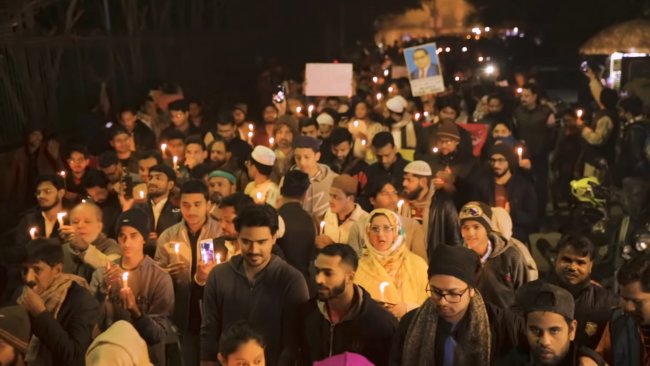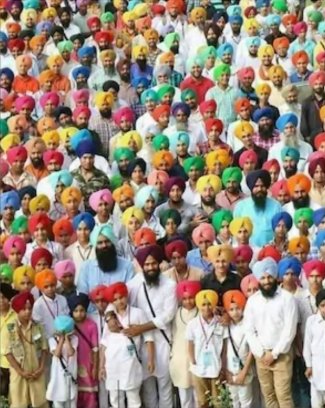Last winter after the Indian government passed the Citizenship Amendment Act (CAA) and began implementing the National Registry of Citizenship (NRC), hundreds of thousands of Indians from all walks of life poured into the streets in protest. The women-led encampment at Shaheen Bagh, a working class Muslim neighborhood in Delhi, inspired a global movement against Hindu nationalism and authoritarianism.
With my dhol strapped around my neck, I joined protests with hundreds at the Indian Embassy in New York, where I live. Witnessing and participating in these powerful demonstrations challenging discrimination in India, I reflected upon the shabad Koi Bol Ram Ram Koi Khudhai by Guru Arjan Sahib. Penned over 400 years ago, the shabad is a call for religious unity and pluralism, poetically emphasizing the idea that all faiths are paths to the same one Divine (English translation here). The CAA/NRC seemed to represent the polar opposite of our Guru’s words.
So, with the help of Brooklyn-based director Nadia Awad, I decided to make a music video for my version of Koi Bol Ram that highlights and uplifts the protest movement against the CAA/NRC. Since the video came out I have been getting a lot of questions, not to mention a lot of harassment and threats from Hindu supremacists, online. Below I will attempt to explain my rationale and perspective.
What is so bad about the CAA/NRC?
The CAA and NRC are clear examples of the dangerous ideology of Hindu nationalism becoming public policy.
The CAA blatantly discriminates against Muslim migrants to India on the basis of their faith. It provides other religious minorities migrating from Pakistan, Afghanistan, and Bangladesh a right to apply for Indian citizenship, while actively excluding Muslims, including persecuted sects like the Ahmadiyya, the Hazaras, and the Rohingyas.
The NRC, which the government calls a census, is a policy that will by design render millions of mostly poor and mostly Muslim people in India stateless. It is already underway in Assam where people have been forced to provide documents that prove their ancestors lived in India prior to 1971. In many case such documents do not exist.
Along with the Indian government’s assault on the self-determination of Kashmiris last year, the Modi administration is on a path to make the RSS dream of a Hindu India a reality. In additional to obvious discrimination against Muslims in these policies, all religious minorities, Dalits, Mulnivasis, Bahujans, Adivasis, migrants, and queer people are all at great risk.
The massive, diverse protests against the CAA/NRC in India were shut down in March due to the pandemic, but the issue has not gone anywhere. Thousands of arrested protesters and activists are still in jail. A few weeks ago, the Indian Supreme Court just made a disturbing ruling against Shaheen Bagh-type protests that severely limits the rights of peaceful protesters.
Why should Sikhs care?
The Sikh Kaum as a sovereign people has no place in a Hindu nationalist India, or for that matter Muslim nationalist Pakistan. Hindutva Brahminical ideology has long attempted to co-opt Sikhs into the Hindu fold, and this is clearly another trap. Whether you believe in dreams of Khalistan or not, it is clear that Modi’s draconian policies are a slippery slope for Sikhs and other minority groups in India.
And regardless of the impact of these policies on Sikhs specifically, it is our responsibility as Sikhs to raise our voices against the oppression of any community. Indeed this is at the heart of the message of sarbat da bhala—working for the benefit of all human beings, not just ourselves.
Not surprisingly, Sikhs participated in the protests in Delhi and beyond in large numbers, including by serving langar to protesters at Shaheen Bagh. The Akal Takht also extended its support for the protests.
If we take our Guru’s message to heart, “Koi bolai ram ram koi khudai. Ko sevai gusaia koi allahi,” we should be doing everything in our power to stand up for the rights of Muslims who are currently under attack in India.
How can you use Gurbani in this way?
For me, Sikhi is an active faith and way of life. Gurbani is not simply meant to be recited while sitting quietly in our rooms or gurdwaras. Gurbani is a call to action.
I’ve been asked by some, “How dare you politicize Gurbani?” I find the question quite ironic when I think about the persecution our Gurus and their followers faced for reciting these words and putting them into action, for making these bold claims denouncing tyranny and caste oppression and religious intolerance. Gurbani has always been political. Indeed, at the heart of Sikhi is a politics of revolutionary love and anti-oppression.
A better question to ask is: How is Gurbani informing the way I live my life, including my political choices, my activism, my service to humanity?
Why now?
As someone who has lived in the United States my whole life, I see frightening parallels between the rise of Modi-ism in India and Trumpism here—empowering Hindu nationalists on one side of the coin, empowering white nationalists on the other. As we approach the biggest election of our lifetimes here in the US, I wanted to release this video—and this message of unity and resistance to fascism—now.
Our world does not have to be so seeped with hatred, violence, and inequity. The images of the intergenerational protest movement in India are a reminder of what we’re fighting for—perhaps a glimpse of what justice looks and feels like. I hope it provides some much needed inspiration and hope in these times of anxiety and despair.
Watch the video for Koi Bol Ram here. Listen or download the track here.



